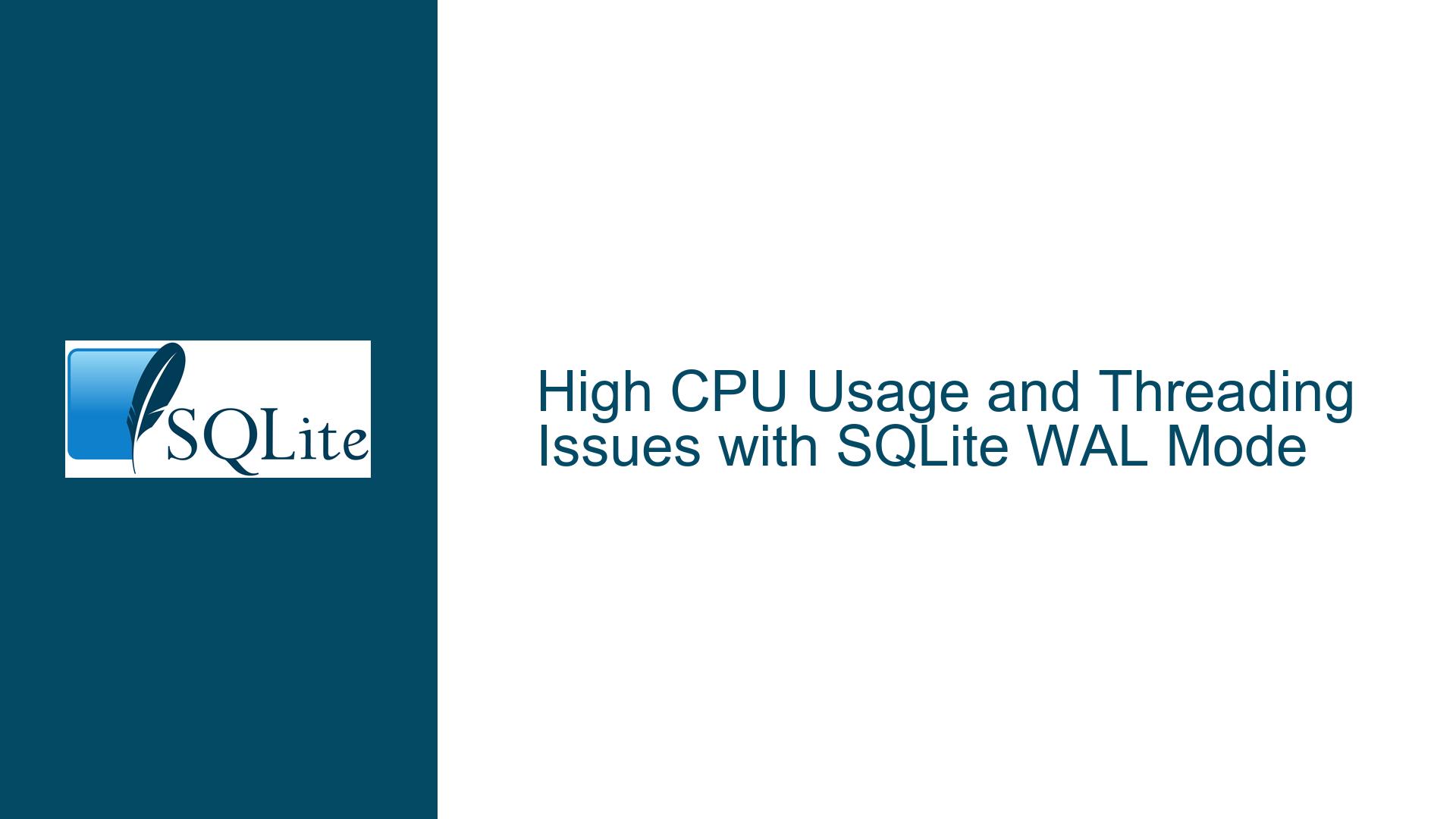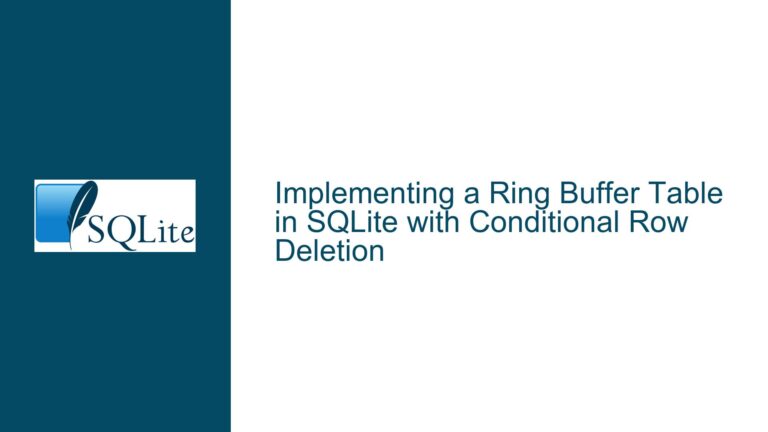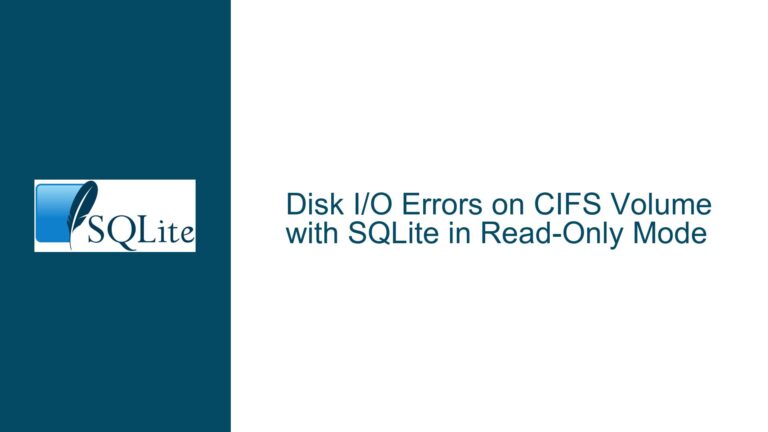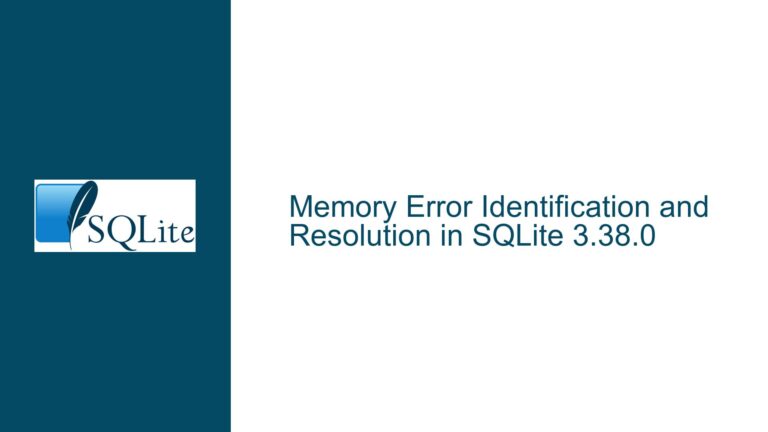High CPU Usage and Threading Issues with SQLite WAL Mode
High CPU Usage in Multi-Threaded SQLite WAL Mode with Busy Handler
When using SQLite in a multi-threaded environment with the Write-Ahead Logging (WAL) journal mode, high CPU usage can occur due to frequent busy handler calls. This issue is particularly pronounced when multiple threads attempt to write to the database simultaneously, leading to contention for the write lock on the WAL journal. The busy handler, which is designed to manage retries when the database is locked, can end up in a tight loop, consuming significant CPU resources. This scenario is exacerbated when the synchronous mode is set to NORMAL, which, while improving performance, reduces the durability guarantees and can lead to more frequent contention.
The core of the problem lies in the interaction between the WAL journal mode, the threading mode, and the busy handler implementation. WAL mode allows multiple readers and a single writer, but it does not eliminate the need for proper thread synchronization. The threading mode determines how SQLite manages concurrent access to its internal data structures, while the busy handler manages retries when the database is locked. Misconfigurations or misunderstandings of these components can lead to performance degradation and high CPU usage.
Interrupted Write Operations and Busy Handler Contention
The primary cause of high CPU usage in this scenario is the contention for the write lock on the WAL journal. When multiple threads attempt to write to the database simultaneously, only one thread can hold the write lock at any given time. The other threads must wait, and if a busy handler is implemented, these threads will repeatedly call the busy handler in a tight loop, consuming CPU resources. The busy handler’s role is to manage retries when the database is locked, but if it is not implemented correctly, it can lead to excessive CPU usage.
Another contributing factor is the configuration of the synchronous mode. When set to NORMAL, SQLite does not flush data to disk as aggressively as it does in FULL mode. This can lead to more frequent contention for the write lock, as the database is not waiting for data to be safely written to disk before releasing the lock. This configuration can improve performance but at the cost of increased CPU usage due to more frequent lock contention.
The threading mode also plays a role in this issue. SQLite offers several threading modes, including SERIALIZED, MULTITHREAD, and SINGLETHREAD. The threading mode determines how SQLite manages concurrent access to its internal data structures. In MULTITHREAD mode, SQLite does not protect against concurrent modifications to connection-related data, which can lead to issues if multiple threads attempt to modify the same connection simultaneously. In SINGLETHREAD mode, SQLite disables all internal synchronization, which can lead to undefined behavior if multiple threads attempt to access the database concurrently.
Implementing PRAGMA busy_timeout and Optimizing Thread Synchronization
To address the high CPU usage and contention issues, several steps can be taken. First, it is essential to configure the busy handler correctly. Instead of implementing a custom busy handler that busy-waits in a tight loop, use SQLite’s built-in busy handler by setting the PRAGMA busy_timeout. This pragma allows you to specify a maximum time (in milliseconds) that SQLite should wait for a lock to be released before returning a "database is locked" error. The built-in busy handler will sleep for progressively longer periods, reducing CPU usage while waiting for the lock.
For example, setting PRAGMA busy_timeout=60000 will instruct SQLite to wait for up to 60 seconds before returning an error. This approach reduces CPU usage by avoiding tight loops and allows the writer thread to make progress without being constantly interrupted by other threads.
Next, consider optimizing the threading mode. If your application uses multiple threads to access the database, ensure that each thread has its own connection. This approach minimizes contention for connection-related data and reduces the likelihood of conflicts. If you are using MULTITHREAD mode, ensure that no two threads attempt to modify the same connection simultaneously. If you are using SINGLETHREAD mode, ensure that only one thread accesses the database at any given time.
Additionally, consider using a semaphore or other synchronization mechanism to control access to the database. By limiting the number of threads that can attempt to write to the database simultaneously, you can reduce contention for the write lock and improve overall performance. For example, you could use a semaphore to allow only one thread to write to the database at a time, while other threads wait for their turn. This approach can help to balance the load and reduce CPU usage.
Finally, consider the trade-offs between performance and durability when configuring the synchronous mode. While NORMAL mode can improve performance, it reduces the durability guarantees and can lead to more frequent contention for the write lock. If durability is a concern, consider using FULL mode, which ensures that data is safely written to disk before releasing the lock. This approach can reduce contention and improve overall stability, at the cost of some performance.
In summary, high CPU usage in a multi-threaded SQLite environment with WAL mode can be addressed by correctly configuring the busy handler, optimizing the threading mode, and using synchronization mechanisms to control access to the database. By taking these steps, you can improve performance, reduce CPU usage, and ensure the stability of your application.






